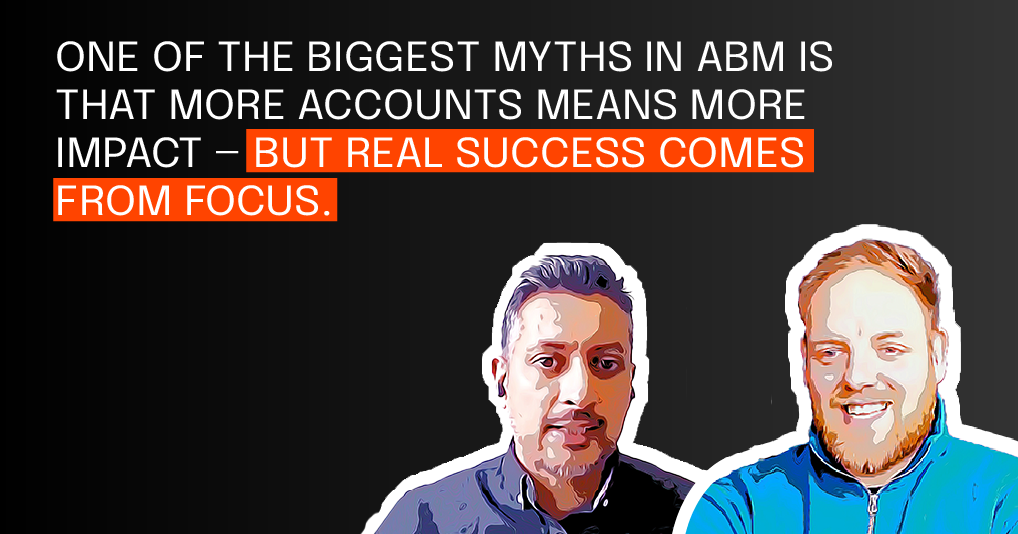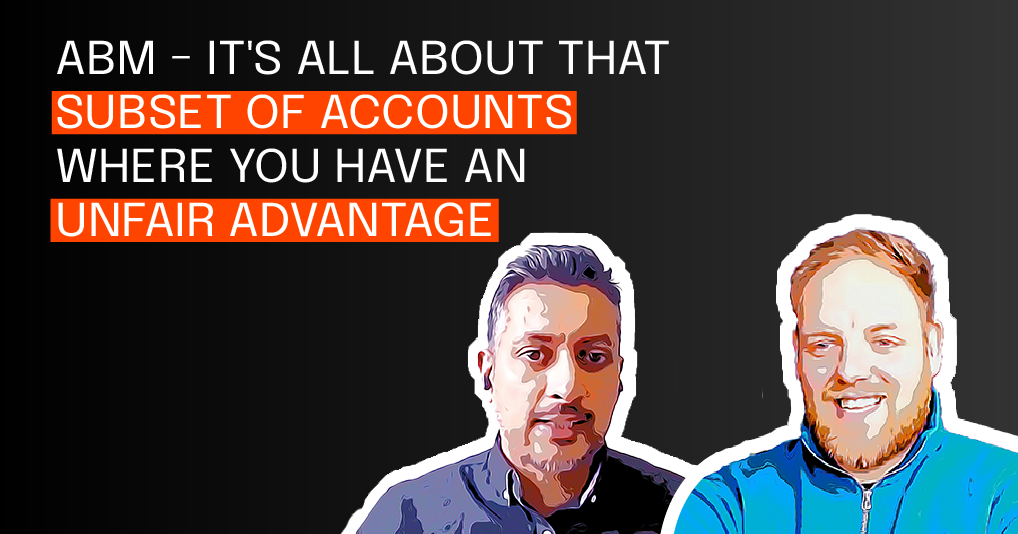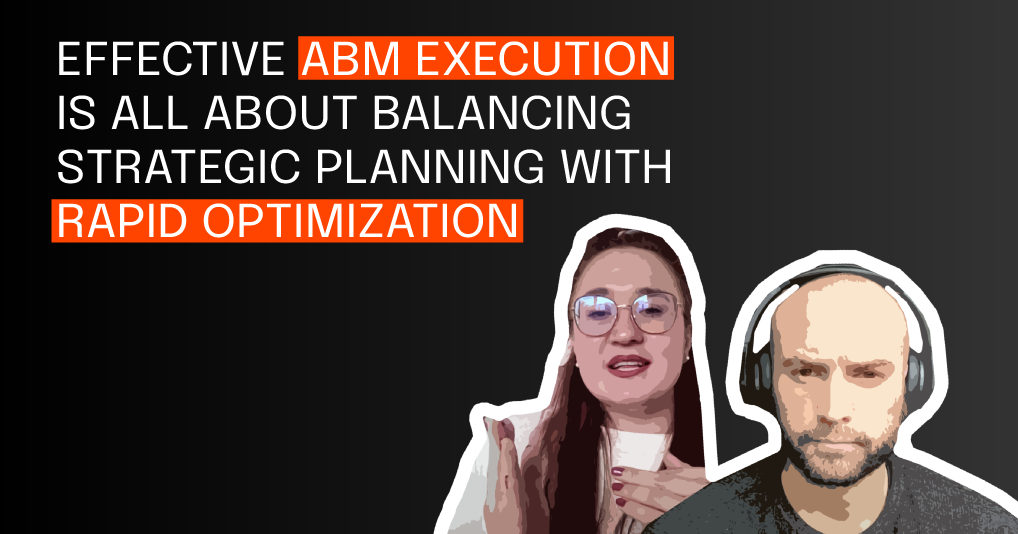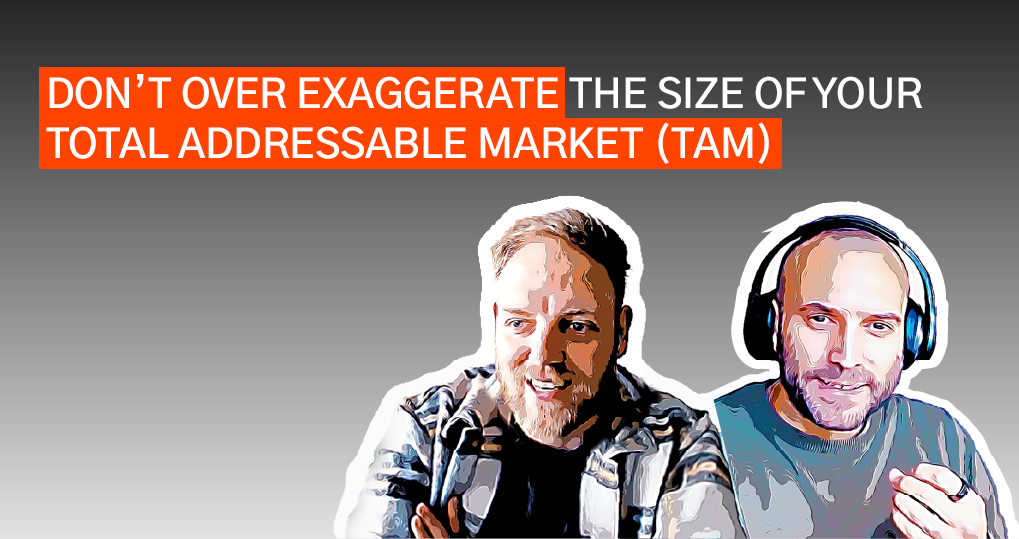Content personalization in ABM
8 January 2024
Jack Rawlings ▪︎ Head of ABM & Lucy Jones ▪︎ Head of Content Marketing
How does personalized content enhance the effectiveness of ABM? From insights, to empathy to content process tips, Jack and Lucy explore content personalization in ABM


With over a decade in B2B content, Lucy is an experienced content specialist. In her role as Head of Content Marketing strategicabm, she works across content strategy and development to ideate, create and bring to life the effective and unique content that ABM programs need.
ABM Lunch and Learn
Fast forward your team's ABM learning and accelerate your growth
We’re on a mission to create great ABMers
Subscribe to our ABM insights and podcast releases.
Why Content Personalization Matters in ABM
How does personalized content enhance the effectiveness of ABM strategies? How do you write a good ABM value proposition? And, are there limits to what you should and shouldn’t personalize?
In ABM, your content is key to connect with accounts. So how can you make sure that content approaches them with empathy, understanding and relevance?
In this episode of ABM Under the Hood, Jack Rawlings explores the world of content personalization with Lucy Jones, Head of Content Marketing at ABM.
Read Podcast Transcript
Jack Rawlings (strategicabm) – Hi there, and welcome to another episode of ABM Under the Hood. This week, I'm pleased to say I'm joined by my colleague Lucy Jones, who is Head of Content here at strategicabm. Thanks for joining, Lucy.
Lucy Jones (strategicabm) – Hey, Jack. Glad to be here.
Jack (strategicabm) – Good stuff, good stuff. So today we're going to be talking specifically about content and mostly around, kind of, the topic of personalization in content when it comes to ABM. So, you know, personalization in ABM is such an important aspect of why ABM can be a successful, kind of, go-to-market strategy. Right?
So, you know, just kind of top level, from your perspective, what do you think personalization and personalized content brings to an ABM strategy or ABM campaign?

Lucy (strategicabm) – Excellent question. I suppose just off the bat, a quick answer is because personalized content is just more relevant, right? So, it'll boost your engagement if it's relevant to someone. It'll build your relationship with them. They'll trust you more if they're reading something that speaks to them. And obviously, that leads into loyalty and revenue over time.
But, I guess what I would do is just take a step back and think about what you mean by 'what is personalization?' Because it can sound like this big scary word in content, right? How do I personalize this piece of content to someone? It could sound really complicated to do it, but really all you are doing is just making a piece of content – whatever that is, whether it's video or something written – you're just making it speak specifically to a person, or an industry, or a business, or your account. And all content does do that to a degree, whether it's ABM or not.
Understanding Personalization: Empathy & Value Propositions
I guess a good place to start with that is empathy. So yeah, if you want to have your content speak to someone, be empathetic. I think of it a little bit like being a method actor as a writer. So any writer, doesn't matter what you're writing or what you're making, will sit in the feeling of who that person is. You know?
I've never been a CEO of a Fortune 500 company. I've never been a CTO, but I do have the insights in ABM and the data to hand to know how that person feels, and I can empathize with them and sort of sit in that feeling of, okay, imagine I've just taken on this role. Imagine I'm sitting at my desk day to day. What are my challenges that I'm facing? What do I need to solve? And how does this piece of content that I'm seeing recognize that?
Jack (strategicabm) – Yeah.
Lucy (strategicabm) – So yeah, a big part of it in ABM is being able to be that conduit between the data, absorbing it, sort of almost becoming that person if you were, and then letting that come out in the content in a way that just reflects what that person needs.
Empathy Mapping in ABM
Jack (strategicabm) – Yeah, I think that's such a great point. And we always try and start with that kind of empathy process, right? We, as an Agency run what we call empathy mapping sessions, which is where we try and get into the mind of the potential buyer or target contact and really understand what their pain points are, their challenges, but more so, kind of, that emotional side of things. What's kind of keeping them awake at night? What are they thinking about all the time? What's driving them? And how can, in our case, our client's solutions help, you know, solve some of those problems for them and what message is required to be able to communicate that and attach that to kind of that feeling that they've got inside?
I think that's an absolutely, kind of, fundamental aspect of why starting with that empathy, you know, in mind is a great approach. And obviously you guys in the Content team are in that kind of mindset all the time, having to kind of shift from one sort of type of person, you know, and their needs and wants to another, which is, you know, where your expertise comes in.
But obviously, from our side on the Strategy team, we kind of provide you guys with as much information and insight and data, as you say, as we can to kind of get you in that state of mind, I suppose, and give you as much information as possible, so you can build that picture up, right? So, what's your kind of process for translating that data and that insight, you know, into the kind of empathetic, personalized message that you're trying to craft?
Crafting a Strong Value Proposition
Lucy (strategicabm) – Yeah, how do we take that profile and create a little personality? So yeah, I suppose what we do is, 'cause there's so much insight, so much data, and so many trends around any account, right? So, anybody who's got, you know, pages and pages and pages of data and insights and statistics, that the best way to start is to just go through it, absorb it, distill it, and then what we do is write it into a value proposition for your campaign.
So that's the quickest way to get anybody working on your campaign to know what is going on with this account, is just to take all of that insight, take all of that data, and turn it into a value proposition. And what that means is, essentially, you are writing some internal text and messaging, which is a summary of what the market, the account, the context around them is about. You're summarizing how your solution relates to them, and just making it really obvious, really clear, really simple, as to what your account needs, what are they struggling with, and how is that solved, in one or two sentences.
So, there are other parts of the value proposition. So that's just your main summary. There'll be a narrative that goes along with that and messaging pillars. So, three or four key imperatives that anybody working on the campaign needs to be aware of. And from there, we kind of distill everything into a bit of a messaging matrix.
So, what are the key priorities for your account personas? Maybe you've got two or three different kind of people that you're running your campaign around. How does this message speak to them? And just give a few little examples that anyone coming in can read and say, "Okay, now I've read that. I get what is the CEO having trouble with? What's the solution related to that? And what will the outcome be if they adopt this solution, essentially?"
Jack (strategicabm) – Yeah, yeah.
Lucy (strategicabm) – And that kind of becomes your Bible, really. Yeah, whatever content it is you want to make after that, whether you are, I don't know, writing an eBook or making a video that speaks to that person, that's your foundation level.
Jack (strategicabm) – Yeah, absolutely. Yeah, I think having that kind of underpinning of a value proposition to be able to refer back to is super important. And also, you know, one thing I think that we see that is really impactful is the ability to kind of layer on personalization into that value proposition, depending on the type of program that we're running, who we're targeting, that kind of stuff.
So obviously, you know, if we are looking at a One-to-many program, the level of personalization is going to be less because we're talking about, you know, a larger number of accounts. You can't necessarily do that level of personalization to each one or each individual within the account.
But as you progress into a One-to-few and a One-to-one, that personalization increases, right? And then, so that means from a messaging perspective, you can add, you know, levels of personalization, whether that's at the account level, whether that's at the stakeholder level, you know, that speaks specifically to that person or to that account. Having that kind of value proposition as a starting point allows you to kind of iterate on that, right? And build on top of it.
Lucy (strategicabm) – Yeah, exactly. Yeah, your One-to-one is your super specific. I'm speaking to, you know, three or four people with this one message. Your One-to-few is more of an industry. So certain accounts within one specific industry, and then One-to-many will be a cluster of things really. It'll be a range. It's much wider scope.
Jack (strategicabm) – Absolutely. So in terms of creating personalized content then, so we've got that value proposition, whether it's kind of the messaging matrix that's kind of speaking at the persona level, or if it's speaking even at the stakeholder level, depending on, you know, the type of program, et cetera. What do you find are some of the challenges in taking that value proposition and turning it into a personalized message or personalized piece of content? Anything that people should be aware of, kind of pitfalls when it comes to personalizing content?
Lucy (strategicabm) – Am I allowed to say all of it?
Jack (strategicabm) – Absolutely.
Lucy (strategicabm) – I mean, there are key stages. Yeah, I suppose, I guess as long as you have a foundation of understanding with that value proposition of who your account is and what they need, a lot of the time the message does just flow through. So, what that will be informed by is, I suppose, your channel tactics, once you know what kind of content will resonate with different people. You can kind of just adjust it.
Jack (strategicabm) – Yeah.
Lucy (strategicabm) – This is a very writer answer, I know, but you yeah. You kind of just absorb the value proposition and go, hey, this is the language, this is the type of messaging, this is the specific industry jargon, and you can kind of just do it.
Jack (strategicabm) – Yeah.
Lucy (strategicabm) – So you might change your headers, maybe, if you've got a piece of existing content, you'll change, I don't know, 20% of it, something like that, and just tweak some of the key trends, the statistics that are coming through it, some of the headers that just jump out in the design.
Jack (strategicabm) – Yeah.
Lucy (strategicabm) – Just to make sure that it's really obvious to the person that you want it to speak to. But a lot of the challenges, I suppose, really are just in terms of creating good content, what makes good content. It's something that's conversational, that speaks the language of the person that you are writing it for. It's something that uses short words unless absolutely necessary. So, I suppose if you're writing for Finance, there are going to be specific Finance terms that you're going to need to use in there.
Jack (strategicabm) – Yeah.
Lucy (strategicabm) – But mostly, you know, people don't want you to sound like a dictionary. You just want to keep it tight on the page, keep it simple. Read it out loud to yourself, as well. So going back to that method actor point, sometimes it helps to pretend to literally be that person and read the content and go, yeah, does this speak to me? Is this how I would want to talk? Is this something that's going to go, yeah, this is right for me and my brain.
And get someone else to read it as well. So, make sure that other people working on the account see it and say, "Yeah, maybe rework that. Maybe change this a little bit."
Jack (strategicabm) – Yeah, I like that. That's a really good tip, actually. And I didn't really think about that, to be honest, because obviously I'm not necessarily the one writing the content for our clients and stuff, so I don't necessarily read that stuff out loud in that way. I obviously read through any documents that you kind of share with me that if it's for my clients and things like that, but I'm not necessarily reading it out loud. I might might start doing that, to be fair. Quite a good tip.
Lucy (strategicabm) – Yeah, no, you can look a little bit crazy at times, just sort of standing in your room reading about, you know, market trends or something.
Jack (strategicabm) – Yeah.
Lucy (strategicabm) – But yeah, it helps you to get that conversational tone and something that's human because what you're trying to do really is be human. You're trying to be authentic. You're trying to be conversational because you know, everyone – doesn't matter if you're in B2B, it doesn't matter if you're a CEO – you don't want to read something that's boring. Yeah. You don't want to listen to something that's boring. You want it to speak to you as a person.
Jack (strategicabm) – Yeah, I think that's such a good point because so much of B2B content historically, has been boring, right? And it's become almost a bit of a meme that like, you know, it's 'Boring-to-Boring' or whatever it is.
Lucy (strategicabm) – Yeah, exactly.
Jack (strategicabm) – It's not always the case. And I've seen great content in B2B, you know, from us and from other areas as well. But there is a tendency towards, because I think people are picturing it as Business-to-Business, right? Whereas actually it's not. It's still person-to-person. It's still human-to-human.
And it's exactly that point of, you know, thinking about the individual behind that, that's reading it. The empathy with them allows you to then create content that is resonant, that is engaging, as opposed to, when you're thinking about it in terms of targeting a business, you are thinking of this kind of faceless, you know, corporation or whatever that it's very hard to kind of create anything that actually feels meaningful or engaging in that scenario, right?
Lucy (strategicabm) – Exactly. And I suppose the other side to that, of being really human, being really connected to your account focus that you're writing for, is just try not to be creepy with it. Because it's possible, 'cause you've got so much data, you've got so much insight, that I guess like Jeff Goldblum would say in Jurassic Park, you know, just 'cause you can do it, doesn't mean you should do it.
Jack (strategicabm) – Yeah, absolutely.
Lucy (strategicabm) – Yeah, like use it in context. So, if someone wants to read an email, don't start talking about, you know, the market trends in detail. You want to be conversational. You want to keep it, you know, light.
Jack (strategicabm) – Yeah.
Lucy (strategicabm) – Where if you've got an eBook, again, don't do it the other way. Don't be like, "Oh, hey Jack, how was last night down the pub?"
Jack (strategicabm) – Yeah, yeah.
Lucy (strategicabm) – Because, you know, got to keep it into context.
Jack (strategicabm) – Yeah.
Lucy (strategicabm) – And don't use it unless you have to.
Jack (strategicabm) – Yeah, no, it's a great point. And it kind of, yeah, it reminds me of that sort of, that phrase like, the medium is the message, right? So, being really aware of what type of message and tone works and resonates on what type of channel and tactic. The way that you speak to someone on LinkedIn is going to be different to how you speak to them on the phone or in a email or anything.
You know, and then particularly the type, you know, if it's more like a webinar-style content or video content, it's going to be different to an eBook. And you know, there's obviously going to be some similarities in terms of the overarching proposition, but the actual, the way that it's kind of crafted is going to be a bit different, right? There's nuances to each type of channel and tactic that you use.
Lucy (strategicabm) – Yeah. Yeah, and that's something that, like, the Strategy team can help you with as well. If you're not sure what an approach is or how is this going to get into market, it's something that, before you start writing, you should definitely understand. Okay, what is this? How is it going to be seen by the audience? And that helps to inform a lot of the language that you use, the choices that you make, why you're writing it.
Jack (strategicabm) – Yeah, yeah, absolutely. I mean, yeah, we work quite closely, don't we, when it comes to that kind of stage, post-value proposition, trying to understand what the kind of creative concept is going to be and the types of channels and tactics and assets that we're going to be creating and building. You know, that's from our perspective in terms of, you know, as a strategic Marketing Agency, you know, there's quite a close alignment there.
And I suppose the equivalent for an in-house team would be the Marketer, you know, the Content Marketer working with the, you know, Digital Marketer or the ABM Lead or whoever, to kind of build that, you know, picture together of the data side, and then the sort of messaging side and the tactics, as well. You know, all of that.
Lucy (strategicabm) – Yeah, it's the same way as, I suppose, as Marketers and Sales teams have to align in ABM. You kind of, it's not just those two teams, it's everybody.
Jack (strategicabm) – Absolutely.
Lucy (strategicabm) – So Sales will feed information into Content based on, I don't know, previous data that they've had, previous interactions they've had from an account. Because that can all change your tone as well. Right? So, if I'm writing a piece of content to an account that already knows about my business, then I'm not going to be starting from scratch like, "Hey, did you know you could improve this and this with my solution?" It's going to be more, "Hey, we've done some great work together, let's build on that."
Jack (strategicabm) – Yeah.
Lucy (strategicabm) – And it just changes the angle of what you're making really.
Jack (strategicabm) – Yeah, for sure. Yeah, absolutely.
Scaling Personalization—Tools & Automation
Okay, so one thing that we sometimes do, depending on the type of program – I think it's more so the case at, you know, One-to-few and One-to-many – is scaling content creation with some level of either automation or just processes that help us kind of scale.
So, you know, one for example is that messaging matrix, right? If you've got a clear picture of like the messaging pillars, you've got three messaging pillars, for example, and you can align those to specific accounts or personas, then you can kind of create, you know, content that is applicable to maybe one or two or three individuals or one or two or three accounts or however many, you know, accounts that you want to be going after.
But there are also other tools as well, right, that we can potentially use. So, is there anything from your side that you use, like, regularly or maybe not as often, but you've seen benefit from in terms of being able to scale and potentially automate some of the content creation process?
Lucy (strategicabm) – It's a very relevant question right now because I suppose AI is on everyone's minds a little bit at the moment.
Jack (strategicabm) – Yeah.
Lucy (strategicabm) – I suppose in terms of scaling, at the moment we are just sort of testing out what could we make more efficient, what could we improve? And I guess the main thing to watch out for, though, is just, so things that you're pushing out to market automatically. So, whether it's email automation or message automation, that's all cool, that's easy. That speeds up the delivery to the audience. Just make sure that, obviously, there's a check and balance with the person there that can jump in with the conversation when it does start.
In terms of AI content, we are kind of using it to see if we can help digest those insights a little bit more. So, where we've got a value proposition or we need to write that specific messaging, we are looking at how we can speed up that distilling process really because, yeah, anything that can pull out those key trends and help us get to it faster, we are looking at.
In terms of actually creating content, and automating that at scale, that's something where I think you just need to be a little bit more careful to make sure that you're being authentic still.
Jack (strategicabm) – Yeah.
Lucy (strategicabm) – Because, I mean, it's ABM. You need to be human. You need to have that constant human connection. And people are getting better at recognizing, I suppose, when content is automated. So always have that check and balance.
If you are using it to create a foundation or a level of something that exists, make sure that you go in and personalize it. Make sure that you've got that messaging back in again from your value proposition that just makes it look unique really, and keeps it authentic.
Jack (strategicabm) – Yeah.
Lucy (strategicabm) – So.
Jack (strategicabm) – Yeah, I think that's, yeah, really good points. And I would say when it comes to that, kind of, the personalizing versus scaling/automating question, for me it's somewhat down to: A) the level of resource you have available to you. Right? You know, the reality is that you can't do personalized content for every single personal target account that you want to do that for. It's just not going to be feasible, unless you've got the world's biggest, you know, content creation team.
Lucy (strategicabm) – Yeah.
Jack (strategicabm) – But, it comes down to be being able to kind of analyze which accounts are the ones that you want to prioritize, right?
So, the second point is essentially that for accounts that are maybe closer to revenue or moving in that direction, that's where you definitely want to start thinking about moving the needle towards the personalization side of things as much as possible, and actually do it, you know, in practise doing personalized outreach and you know, content that is specific to the account or the individual, as opposed to the accounts that are maybe further away from that revenue that are maybe in the awareness stage or pre-awareness, even. That's where you could potentially look at employing some more scaling/automating type tools I think as a first step into things.
Lucy (strategicabm) – Yeah.
Jack (strategicabm) – I would still probably hesitate a little bit to do that when it comes to, like, One-to-few and One-to-one, but it's, certainly in a One-to-many, I think that's feasible.
And then, you know, things like workflows, dynamic content as well, I suppose is the other thing that potentially is something that can be useful. You know, dynamic content I think can sometimes sort of straddle that line between personalization and automation, because if you get it right, and you've got the data inputs right and everything, it can mean that you are serving up content that is relevant and does feel personalized, but actually you're doing it in such a way that it's quite scaled and somewhat automated, right? So.
Lucy (strategicabm) – Yeah, especially if your accounts have got a commonality between them. So like, you know, if they're in a similar market or they've got similar challenges, then you can just tweak certain sections of it.
Jack (strategicabm) – Yeah.
Lucy (strategicabm) – Again, maybe like 20% of what they're seeing on page.
Jack (strategicabm) – Yeah.
Lucy (strategicabm) – You could just tweak that to change, yeah, once they land on that page and it can just adjust.
Jack (strategicabm) – Absolutely. Yeah, and I think for me it, as much as anything else, the setting up... So there's different levels of this right? There's you know, 101 ABM, getting things started, getting content created, blah, blah, blah, which is sort of, you know, it's about just creating personalized content probably as manually as possible, you know, in the start, in the early days.
But then I think there's a point where the technology stack that you maybe have available to you, the kind of foundations that you might have set up can really help with scaling and also can help with automating some of the processes in such a way that it doesn't actually feel like they're being necessarily automated.
So I'm thinking in terms of, like, your CRM setup or your marketing automation setup can be done in such a way that the data is pulled in automatically, the context is pulled in. You know, if someone's been on a page, they can be retargeted or they could be, you know, served up, you know, more relevant content or whatever it might be.
Lucy (strategicabm) – Yeah.
Jack (strategicabm) – But each of these things, to set all of that up in itself is quite a heavy lift, right? So, it's the sort of one-time heavy lift of personalized content versus the longer-term heavy lift, but then eventually kind of running by itself of more automated stuff. But yeah, it depends on how.
Lucy (strategicabm) – Once you've got that you can optimize, right?
Jack (strategicabm) – Yeah.
Lucy (strategicabm) – So, once you've got that one page, you can get people coming in and going, "Oh, this CTA works for this type of person, this CTA doesn't." And you can just iterate and just keep changing it until you get that messaging that works.
Jack (strategicabm) – Yeah, yeah. Absolutely. Yeah, yeah, that's a great point. Yeah.
So obviously, when we're talking about personalization and content and for ABM it's not doing it just for the sake of it, right? Obviously what we're trying to do eventually here is move people towards opportunities, revenue, all of that kind of stuff. So, how do you think about the success, kind of, metrics of personalization in ABM and content? Are there any kind of specific KPIs or points to think about when it comes to how well a personalized piece of content is performing?
Lucy (strategicabm) – I suppose it depends on what your goal is with the content. So, if you are trying to raise awareness, if you've got things like ads in channel, it's, you know, what clicks am I getting on those ads, are they coming through to the content? Are they going to read it? Are they spending a long time on page? Is that relationship starting? Are they aware of who we are?
Jack (strategicabm) – Yeah.
Lucy (strategicabm) – You know, are they seeing that trust? And if people are starting to come through your process, they're starting to book workshops, they're starting to engage with you, reply to your messages, then yeah, you're going to see that reputation build, you can see that trust build, and hopefully, eventually down the line, they're going to eventually buy your product and see revenue.
But obviously, as a Content Writer, that's quite far down the line. And it's something that we work with your team, we work with Strategy, we work with the Sales team to kind of get that information back again and create that loop of "Yeah, this messaging's working, maybe this messaging could do with tweaking a little bit."
Jack (strategicabm) – Yeah.
Lucy (strategicabm) – And just try and see who's reading it. Are they engaging with it? Are you building that reputation, that trust?
Jack (strategicabm) – Yeah, I think that's an absolutely spot on point really in terms of building trust as a sort of overarching lens to view things through, right? Because it's the classic quote of, you know, "People don't buy from people they don't trust."
In order to be able to get to the types of deals that we are usually talking about with ABM where it's, you know, often sort of five, six, seven figures, you're not going to be doing that sort of deal with no trust with the supplier or the solution. Right? So there needs to be that level of trust there, and I think content and personalized content is the perfect way to do that.
Measuring Success: KPIs & Building Trust
And it's not going to be one piece. It's not going to be two or three, potentially. You know, it could be lots and lots of engagements and interactions before that trust is built to the level that it needs to be in order to have that opportunity and deal come through.
Lucy (strategicabm) – Yeah, yeah, it's not going to be one magic piece. You're not going to write one magic blog post.
Jack (strategicabm) – No.
Human-Centered Content
Lucy (strategicabm) – And even now, like more human content I think is going to just get bigger and bigger as we go through. So things like podcasts like this or video or face-to-face stuff that is authentic, that does show you who someone is, you know, you hear someone's voice.
Jack (strategicabm) – Yeah.
Lucy (strategicabm) – It's just going to start building that, like you say, that human trust.
Jack (strategicabm) – Yeah, absolutely. I think the biggest sort of white space, open space for B2B Marketing and ABM over the next couple of years is going to be around that kind of influencer marketing approach.
Lucy (strategicabm) – Yeah.
Jack (strategicabm) – Building the personality and the reputation through individuals within the business. You're starting to see it happen now already. There's a couple of, kind of, key influences in certain areas. I mean more so in B2B Marketing itself and ABM itself, if that makes sense. But there will be in other industries, in B2B industries as well, you know, thought leaders, personalities, that mirrors the sort of growth of, you know, YouTubers and TikTokers and vloggers and whatever else on the sort of more B2C side or the more, that kind of content creation side. I think there's a big opportunity for businesses to tap into that.
And again, it comes back to that empathy side of things, right? It's easier to build that empathy when you are coming from a peer-to-peer, person-to-person kind of perspective, I would say.
Lucy (strategicabm) – Exactly. Yeah, and it goes back to what you were saying before as well. That B2B doesn't have to be boring. It can be closer to B2C because, especially in ABM, you are speaking to a person. You're speaking, well, I mean, you're always speaking to a person, whatever the content is, but it's easier to see it as individuals, as you know, specific businesses.
Jack (strategicabm) – Yeah.
Lucy (strategicabm) – And yeah, we've come a long way from gated eBooks, I think.
Jack (strategicabm) – Yeah, absolutely. Yeah, yeah, for sure. Well, I know on that theme actually, so we've had a question from Charlie Langley who's wanting to try and push the boundaries of, sort of, her hyper-personalized content and ABM activities. She wants to understand where people potentially think we'll be getting to in a few years time with personalized content.
Tailoring Content for Different ABM Program Types
We've kind of touched on that a little bit in terms of AI and maybe the influencer side of things, as well. But what does it actually look like in practise? Like what types of content are we looking at? She asked, "Is it just going to be a case of ever more personalized eBooks or are there more exciting, kind of, content possibilities that could emerge?"
Lucy (strategicabm) – Wow, well, I think the possibilities are as wide as you want to make them. First of all, again, go back to that start, that audience. Who are you speaking to? What does that person, what are they going to engage with? You know, if they're a decision maker, maybe they want some more quick-form content, something that speaks more to their challenges more directly, how are they going to raise revenue? That kind of thing.
If they're more of an influencer-type personality, maybe they'll have the time to go into the weeds of what it is you want to talk about. So something that's a little bit more in depth, but yeah, things that are more human-based, I think will get bigger and bigger over time. So podcast, video, direct messaging, chat bots, anything that's direct one-to-one.
Jack (strategicabm) – Yeah.
Lucy (strategicabm) – And just, yeah, don't always feel that you need to funnel things towards a workshop either, I think, which is a good way to go. You see it quite a lot in B2B that it's always, we're trying to get you to our demo, we're trying to get you to our workshop.
But remember that the person you're speaking to might not have the time for that or they might not want to engage in that way. So, not everyone wants to join a Zoom call. Not everyone wants to join a video.
Jack (strategicabm) – Yeah.
Lucy (strategicabm) – So, think about what formats are going to engage that person. Are they going to be more susceptible to engage with an FAQ page or something they can take away themselves, you know?
Jack (strategicabm) – Yeah, yeah. I think that's absolutely spot on because there is a, definitely a tendency to try and get people onto a call – whether that's a demo or a workshop as you say, or just on the phone. And absolutely, if you can get to that point, often that is a good way of getting your foot in the door, right?
But the issue is, as you say, people are busy. That's not always the right thing for them in that moment in time. And actually, sometimes it can be off-putting, even if they're not ready to buy, if they're not ready to have that conversation to then get on a call with someone, it can actually be quite, yeah, it can actually put things back a little bit and having that, identifying what that kind of pre-call stage may look like or what an alternative to that may look like is I think probably where things could be differentiated the most in the coming years.
Personalized Journeys
Because there's opportunity for that, as you say, that kind of like self-serve content, potentially kind of like learning-type content as well, training that sort of stuff, potentially, the types of content that allow someone to make a business case internally. So things, you know, whether it's battle cards or product sheets or, you know, ROI calculators or anything of that ilk where you can kind of then take things back into the business and make your case.
You know, people aren't stupid. They don't need necessarily to be handheld through everything all the time. And actually, often it's a case of giving them the tools that they need in order to be able to, you know, get to where they want to get to. So, I think that's, yeah, absolutely, A really good point that not everything has to be leading to that workshop or demo call, for sure.
Lucy (strategicabm) – Yeah, and as a Content Writer, work with your Sales team, work with your Strategists, use that insight that they have and just figure out who is this person I'm talking to? What actually do they want? Not what do I want them to do, necessarily.
Jack (strategicabm) – Yeah, yeah, yeah.
Lucy (strategicabm) – And build it around that side of it.
Jack (strategicabm) – Yeah, yeah, yeah, it's absolutely a great, great shout 'cause I think people are, you know, Marketing still works a hundred percent, it still works, but people are wise to the kind of the tricks and the sly, you know, tactics and stuff. It's a lot more about being authentic and building that trust, as we've kind of mentioned, that, you know, the more real you can be, the more likely you are to have that relationship with someone and be able to actually then translate that into something positive, you know, in terms of opportunities and stuff down the line.
But yeah, good stuff. Well, Lucy, thank you so much for joining me today. It's been been a pleasure to chat to you, and I'm sure we'll have you back on again soon, as well, if you'd like to discuss more areas around content, I'm sure. But yeah, thanks for joining me today, and we'll catch up soon.
Lucy (strategicabm) – Excellent. Thanks Jack. It's been a pleasure.
Jack (strategicabm) – Cheers.
Key Takeaways & Next Steps
1. Use empathy to shape your message.
2. Match personalization to the ABM program type.
3. Leverage tools and AI carefully for scale.
Be sure to check out all episodes of ABM under the Hood
Make sure your ABM engine is finely tuned. Subscribe to future episodes.
Let's talk
Looking to start your ABM journey or need help with your current program? We'd love to know more.
Here's a simple form to start the conversation
Alternatively - grab a time here to talk
- Follow strategicabm on X
- Follow strategicabm on LinkedIn
- Follow strategicabm on Facebook
- Follow strategicabm on YouTube
- Follow strategicabm on Instagram
© 2026 strategicabm / Strategic ABM Ltd. All Rights Reserved | Privacy
Strategic ABM Ltd is a private limited company registered in England & Wales. Registration number 13082021.
HubSpot Platinum Partner
Google Certified Partner
Nexus Gold Accredited Partner










